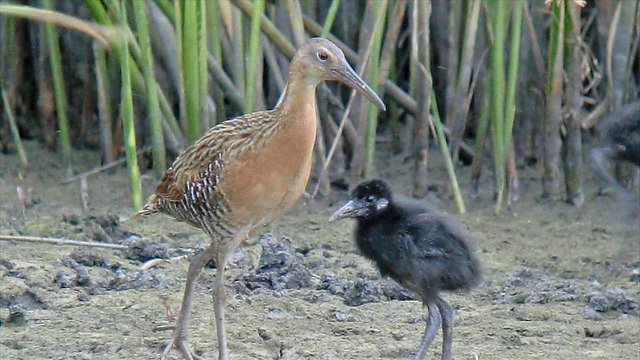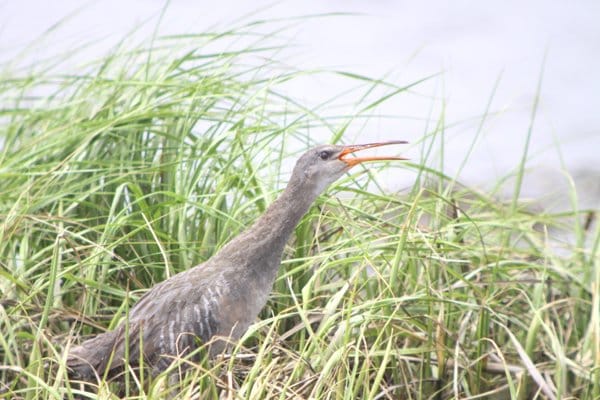
Clapper and King rails (Rallus longirostris and R. elegans) are the largest rails in the Americas. Their taxonomic status long has been unclear due to their overall similarity and the fact that in eastern North America and Cuba, they hybridize. But some recent work by James Maley and others is shedding more light on these secretive and fascinating birds.
Clapper Rails, as currently defined by the AOU, occur along the coasts of North and South America and Caribbean islands, and inland in southern California and Arizona. The photo above, one of mine, shows a Clapper Rail in Louisiana. King Rails occur widely in eastern North America, in eastern and central Mexico, and in Cuba.
In eastern North America, birders think of King Rails as richly colored birds of freshwater marshes, while Clapper Rails are considered drabber birds of saltmarshes. In California and Arizona, however, Clapper Rails are brightly colored and occur in both salt and freshwater environments. South of the ABA area, the picture is further complicated, but more on that in a bit.
Clapper Rail of the grayish U.S. Atlantic Coast subspecies crepitans in New Jersey by Corey Finger
In his doctoral dissertation — Ecological Speciation of King Rails (Rallus elegans) and Clapper Rails (Rallus longirostris) — for Louisiana State University, James Maley uses new genetic analyses and other data to identify three major groups within the Clapper-King complex:
- An eastern clade comprising Clapper Rails of eastern North America and the Caribbean plus all King Rails except those of the central Mexican highlands;
- A South American Clapper Rail clade;
- A clade comprising Clapper Rails of California, Arizona, and northwest Mexico plus King Rails of the highlands of central Mexico.
Maley then goes on to examine the hybrid zone between Clapper and King rails in Louisiana, finding that the hybrid zone is very narrow (about 4 kilometers, or 2.5 miles) and appears to depend on the presence of brackish marsh; where saltmarsh and freshwater marsh were immediately adjacent due to human manipulations, he found that birds did not interbreed.
High quantities of salt can be deadly to birds (and many other living things), so rails living in saltwater environments have glands in their heads that excrete extra salt to maintain an internal balance conducive to life. In freshwater rails, this gland is smaller, and the birds do not fare well in saltier environments.
Maley’s genetic work shows that the saltwater and freshwater populations are maintaining their distinctiveness in Louisiana. The birds’ mitochondrial DNA shows that, despite rails’ propensity for long-distance travel, the freshwater and saltwater populations are not two ends of a spectrum but rather maintain their distinctiveness despite the occurrence of hybridization in brackish environments. The full study is fascinating and well worth a read.

King Rail and chick in Illinois cc-by Andy Reago
So, Maley suggests recognizing four species, instead of the two currently recognized. These would be as follows (no English names proposed):
- Rallus longirostris of South America, comprising the subspecies longirostris, phelpsi, margaritae, pelodramus, cypereti, and crassirostris. All of the subspecies in this complex are currently treated as part of the Clapper Rail complex. They are pale, thick-billed birds of mangrove environments.
- Rallus obsoletus, which would include the subspecies obsoletus, levipes, yumanensis, and beldingi of California, Arizona, and northwest Mexico, plus tenuirostris of freshwater wetlands in the central Mexican highlands (this population is currently treated as part of the King Rail complex). These birds are all relatively brightly colored. The Pacific Coast populations are endangered.
- Rallus elegans, which would presumably keep the name King Rail and would include the subspecies elegans of eastern North America and ramsdeni of Cuba. These are brightly colored birds that breed in freshwater environments.
- Rallus crepitans, variably colored saltwater birds of eastern North America and the Caribbean, including the subspecies crepitans, waynei, scottii, insularum, saturatus, caribaeus, pallidus, grossi, belizensis, leucophaeus, and coryi.
So when might we see the AOU or other bodies deliberate this information? Maley has a forthcoming paper in The Condor (Mitochondrial and Next-Generation Sequence Data Used To Infer Phylogenetic Relationships and Species Limits in the Clapper/King Rail Complex) that should provide the published evidence needed for taxonomic bodies to act, or at least open the discussion.
I should also note that the abstract for the Condor paper proposes five, not four, species. Perhaps tenuirostris of Central Mexico is proposed as a full species, instead of being lumped with the endangered Pacific and Baja populations?
What do you think? Do the arguments in Maley’s thesis make sense to you? What English names would you propose if the complex is split into four or five new species? And what are the conservation implications of elevating the endangered Pacific populations to full species status?














I bring this up again, as no one has yet proffered an answer. Genetic studies on bird populations are almost always done on mitochondrial DNA. The mitochondria are in the cytoplasm, not the cell’s nucleus. They have nothing at all to do with the
nuclear DNA of classic genetics. Although mitochondrial DNA does replicate as new mitochondria are produced, no sex is involved. This DNA, a product of the egg’s cytoplasm is passed down only from mothers to their offspring, both male and female. Your mitochondrial DNA is completely from your mother, in perpetuity. You will pass your mother’s mitochondrial DNA to your children if you are female, and it will not pass at all if you are male.
Mitochondrial DNA is used in genetic studies because of its higher mutation rate, making it more valuable when looking for changes. But identifying a group of birds as a “species” implies that the group is reproductively isolated from other groups. That’s the original, time-honored and respected definition. In the case presented here, a female rail could be fooling around with males
of nearby clades, produce viable young, and no one would know because they are only looking at the mitochondrial DNA. You can’t show rep[roductive isolation by looking at a product that only comes from mothers, any more than you can define a household income by only looking at the salary of one of the adults living there. This is no way to define a new species. True, there are definable differences in clades. The need for cubbyholes for all these forms is why there are subspecies in the first place.
@steve:
This study looked at both mitochondrial and nuclear DNA. Also, if both sexes are interbreeding with other clades, the two mtDNA lineages will be spread throughout both species. If only one sex/species alignment is viable (such as if female Clappers could breed with male Kings but not the other way around, sort of like how mules are made), they can’t really be said to interbreed freely.
Koyomi,
You assume that individual clades are not only interbreeding, but taking up residence in each others territories. If clade mtDNA mixing occurs, say on common wintering grounds, then the females later retreat to their own territories, you still can’t tell if interbreeding occurred from mtDNA. (I assume here that specimens were obtained on home territories). I haven’t read this study, and appreciate that nuclear DNA was also used, but in other studies supporting the epidemic of split-itis, it is not.
That would require all of the female hybrids to return to their mothers’ breeding grounds. Even so, in the absence of selection against intermediate forms, significant nuclear DNA transfer would likely reveal itself phenotypically.
Steve,
I highly recommend reading the dissertation. I realize you’re discussing the issue of mtDNA as a sole marker for doing taxonomy a bit more broadly, but it is not an issue with this particular project. James has reams of next-generation nuclear DNA sequencing data that shows hybridization dynamics at a fine scale.
Also, your statement that “Genetic studies on bird populations are almost always done on mitochondrial DNA” is not really true anymore. It definitely used to be, but the perils of taxonomy-by-mtDNA are well-known now, and splitting species (and getting papers published) based only on mtDNA is a dying practice, IMO.
Excellent news, Nick. I don’t mind being left in the dust if the truth will finally prevail.
Fascinating news (particularly identifying the hybrid zone on such a fine scale, and how salt is such a big obstacle to interbreeding) AND discussion. Thanks everyone.
Thanks David for the excellent article summarizing my research on this complex! Thanks Nick for helping to shed light on the complexities of the research and the current state of bird taxonomy in light of genetics. I wanted to point out that this work was done with Robb Brumfield (my adviser).
In the forthcoming article we suggest common names and detail our reasoning, which goes far beyond mitochondrial clades. As intimated in the article, we also suggest splitting R. e. tenuirostris from the southwest North American group.
How does the study explain the significant differences in the calls of each bird/ species?